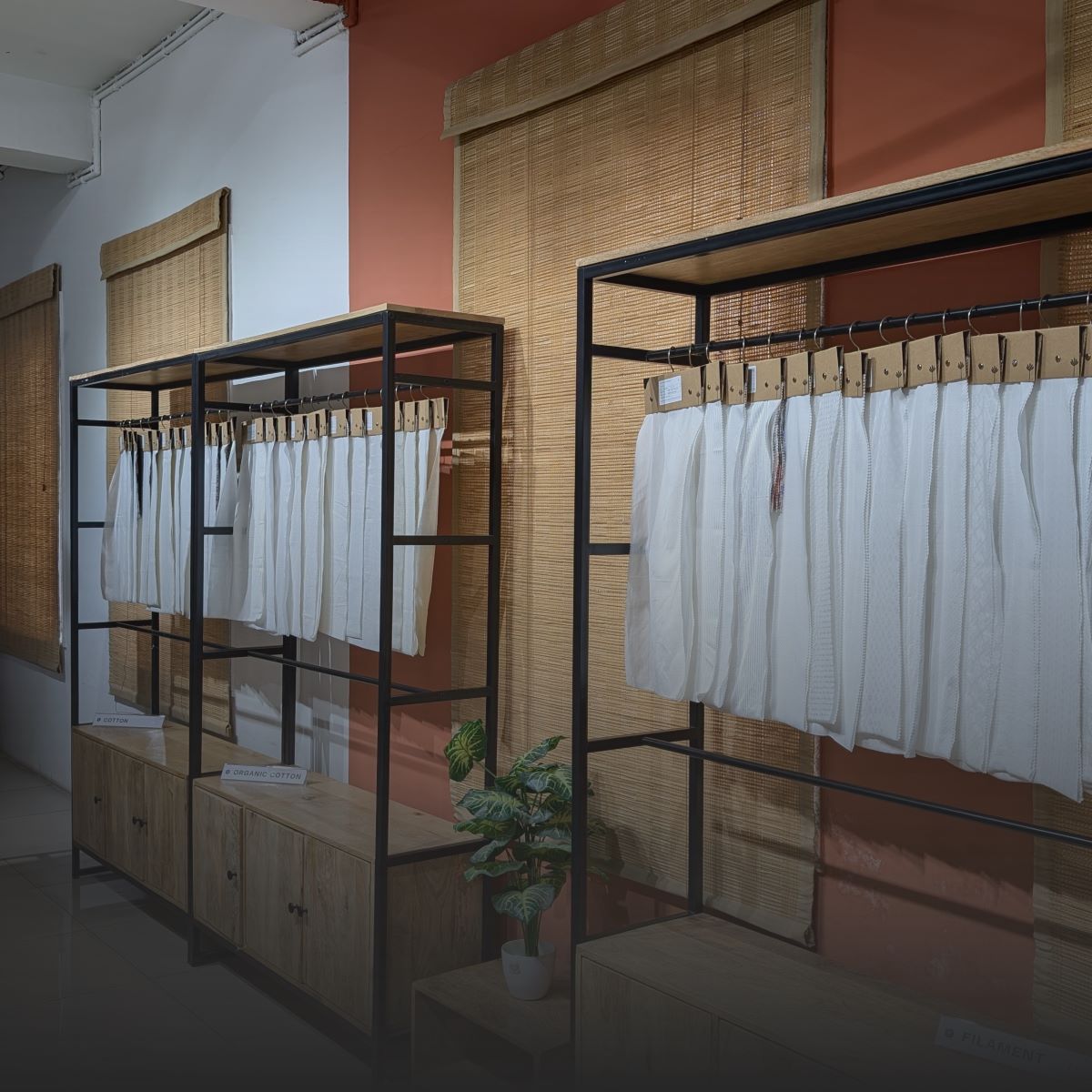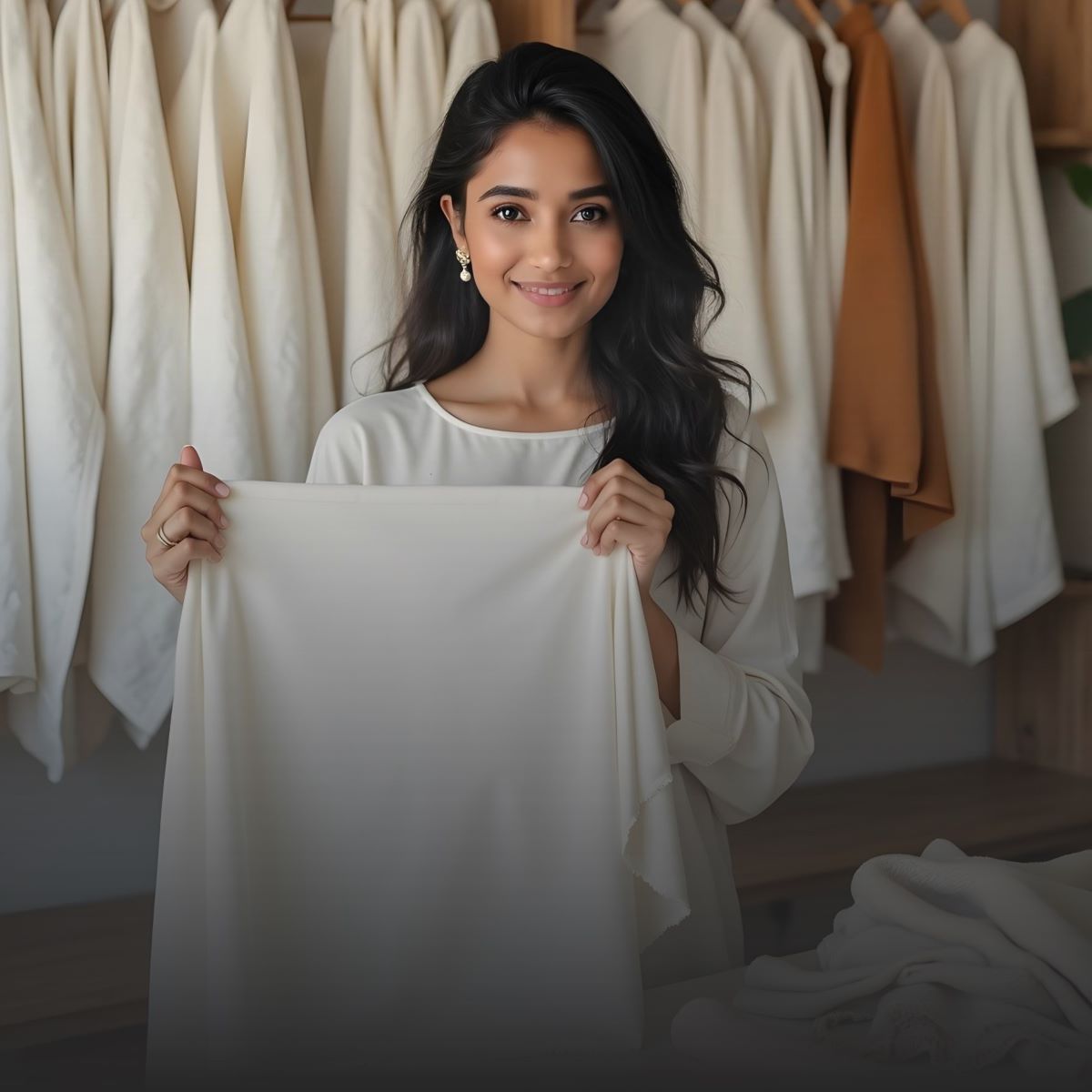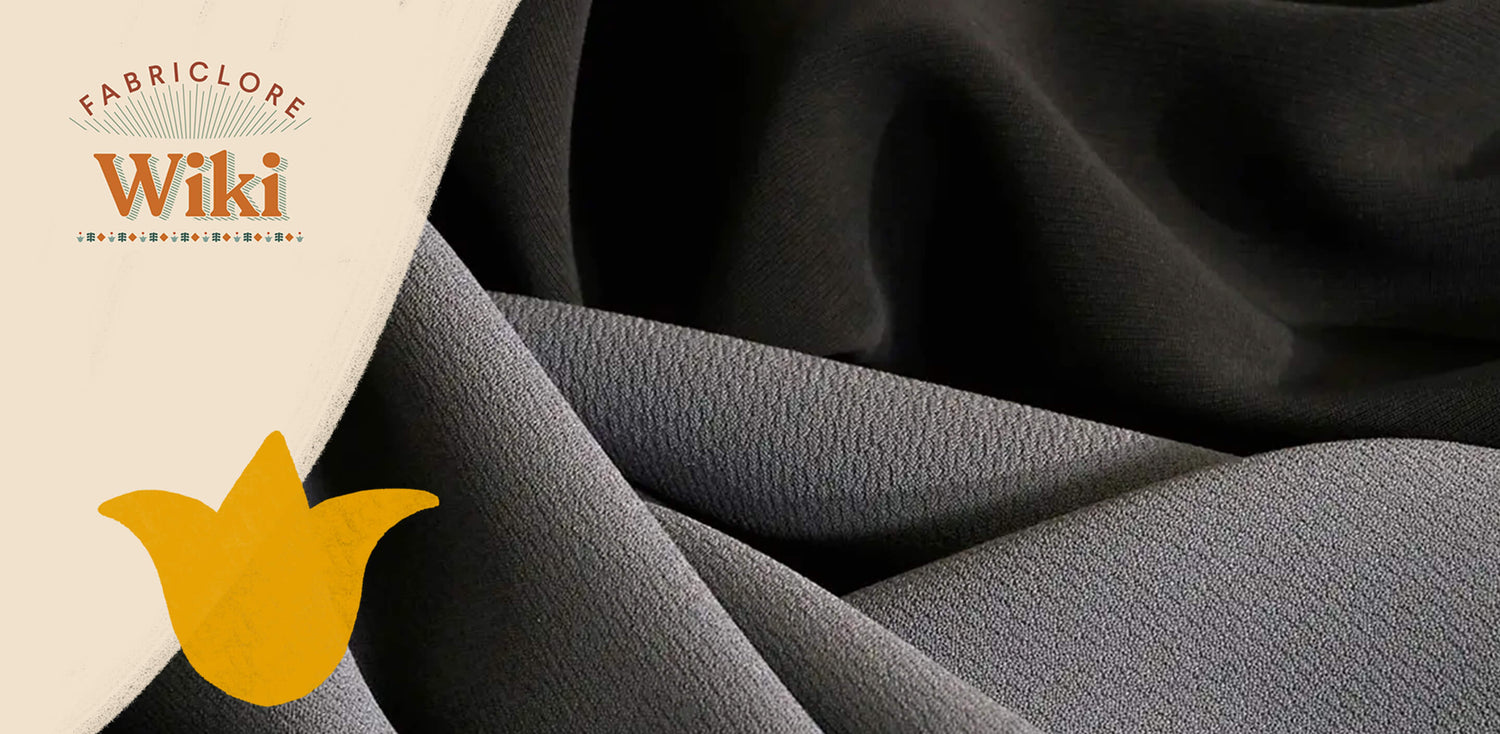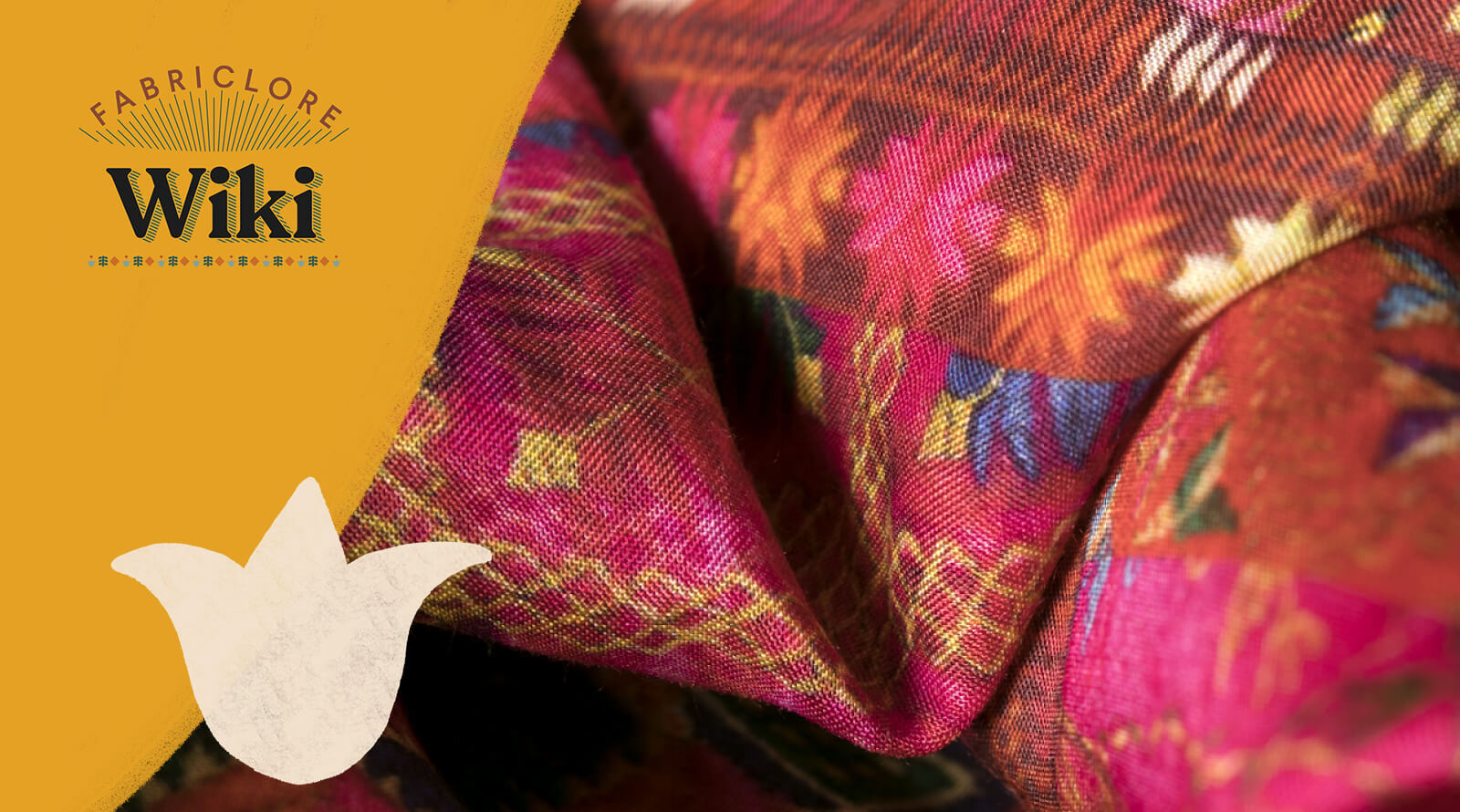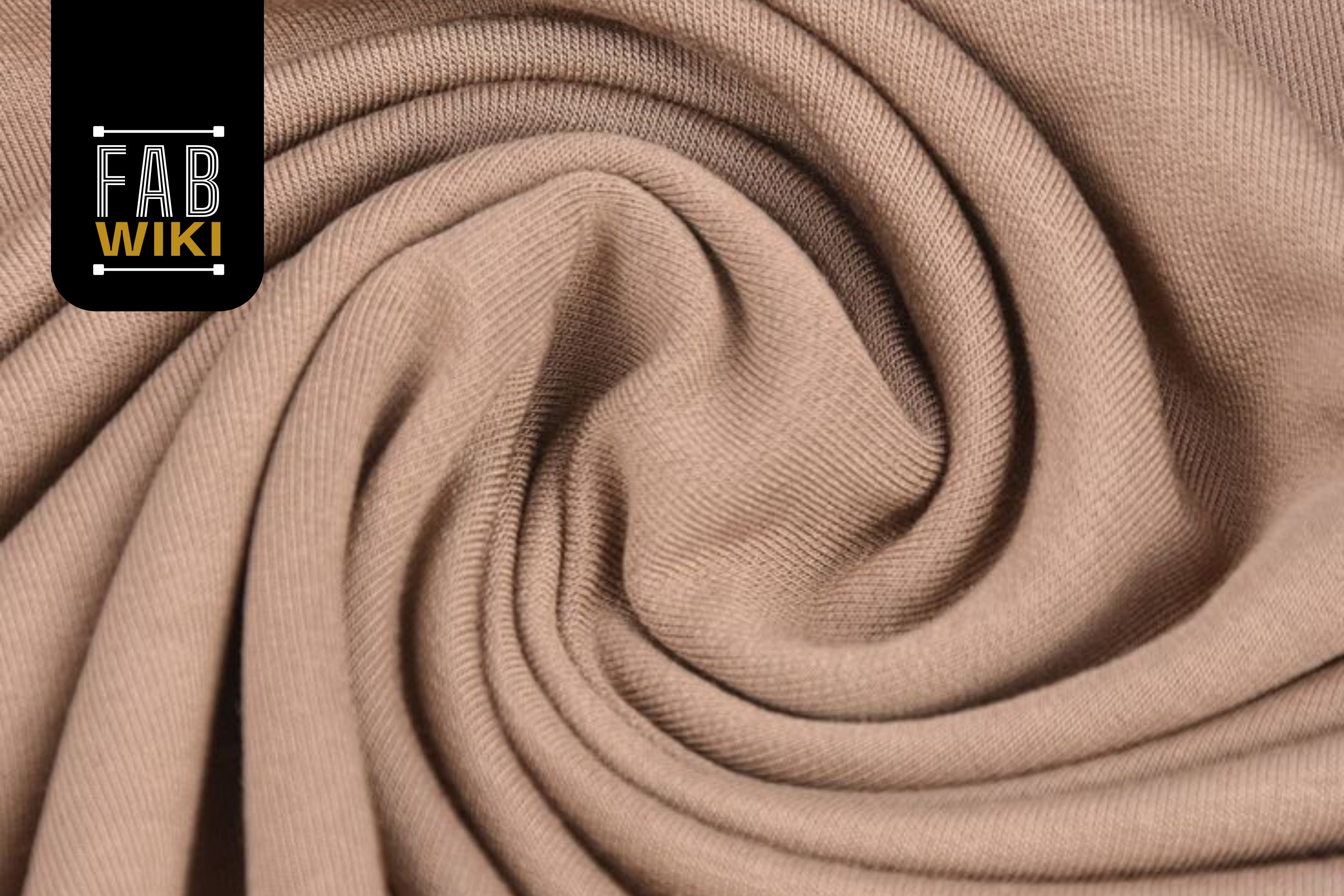| Property | Description |
| Fabric Type | Synthetic fabric made from PET (polyethylene terephthalate). |
| Origin | Developed in the 1940s, with PET patented in 1941. |
| Composition | Made from petroleum-based chemicals, often blended with natural fibers. |
| Durability | Strong, resistant to shrinking, stretching, and wrinkling. |
| Texture | Can be smooth, soft, or brushed depending on the finish. |
| Breathability | Low, can trap heat and moisture in hot weather. |
| Applications | Clothing (shirts, dresses, sportswear), home decor (upholstery, curtains). |
| Sustainability | Not biodegradable, but recycled polyester (rPET) and plant-based options are eco-friendly. |
| Advantages | Affordable, durable, low maintenance, and holds bright colors well |
| Disadvantages | Can be uncomfortable in heat, traps odors, and isn’t breathable. |
| Care |
Easy to wash, avoid high heat for drying or ironing. |
Introduction to Polyester Fabric
- Polyester is a synthetic fabric made from petroleum based chemicals, mainly polyethylene terephthalate (PET).
- It is created through a process called polymerization.
- Polyester is known for its strength and resistance to shrinking, stretching and wrinkling.
- It is widely used in clothing, upholstery and other products.
- Polyester fabric is versatile and affordable.
- It can be made into different textures, ranging from smooth and shiny to soft and brushed.
History of Polyester Fabric

- Polyester, a fabric used widely in fashion and industry, has an interesting history that began in the 1920s.
- Wallace Carothers, working for DuPont, helped create synthetic fibers by studying large molecules.
- While Carothers first created nylon, it was British scientists Whinfield and Dickson who, in 1941, patented polyester’s main compound, PET.
- This led to the development of the first polyester fibers, changing the textile world forever.
- In the 1950s, polyester became known as a low maintenance, wrinkle resistant “miracle” fabric and quickly became popular.
- Over time, polyester became more versatile, turning into blends and microfibers used in everything from outerwear to everyday clothes.
What is Polyester Fabric?
- Polyester is a strong, affordable fabric made from PET (polyethylene terephthalate) derived from petroleum.
- It is wrinkle resistant, keeps its shape and holds colors well.
- Commonly used in clothing, home decor and various products.
- Often blended with natural fabrics like cotton and wool to enhance durability.
- Easy to care for and long lasting but not biodegradable, posing environmental concerns.
- Despite environmental drawbacks, polyester's versatility is vital in today's market.
Modern Innovations in Polyester Fabric
- Once criticized for its environmental impact, polyester is becoming more eco friendly due to new technologies.
- Methods like waterless dyeing help reduce water use and pollution.
- Chemical recycling allows polyester to be reused, cutting down on waste.
- Companies are now using recycled plastic bottles and renewable energy sources like wind and solar power in production.
- Plant-based polyester, made from materials like cornstarch and sugarcane, offers a more sustainable alternative.
- These innovations are helping make polyester a more eco-friendly option for the future of fashion.
What Makes Polyester Fabric Special?

- Polyester is a strong, durable fabric that lasts longer than many others, maintaining its shape after washing.
- It is wrinkle resistant, making it ideal for everyday wear and travel.
- Polyester can be soft and available in various textures, like smooth satin or warm fleece.
- Affordable and capable of holding bright colors well, it’s a popular choice in fashion and everyday items.
- With its blend of strength, comfort and low cost, polyester is widely used in many products
Types of Polyester Fabric:
|
Type of Polyester |
Description |
Key Features |
Common Applications |
|
Ethylene Polyester (PET) |
The most common and widely used form of polyester is often simply referred to as polyester. |
Excellent strength, durability, moisture wicking properties. |
Clothing, sportswear, home furnishings, packaging. |
|
Plant-Based Polyester |
Made from renewable resources like cornstarch and sugarcane, it is an eco friendly alternative to conventional polyester. |
Biodegradable, eco friendly, more expensive, less durable than PET or PCDT. |
Sustainable fashion, eco conscious products. |
|
PCDT Polyester (Poly-1,4-Cyclohexylene Dimethylene Terephthalate) |
A less common polyester, known for its excellent elasticity and durability. |
High elasticity, more durable than PET, maintains structural integrity over time. |
Upholstery, curtains, industrial textiles, heavy-duty applications. |
Features of Polyester Fabric
- Polyester is a strong fabric that lasts a long time and is resistant to stretching, shrinking and fading.
- It maintains its shape and color even after washing and is wrinkle resistant, making it easy to care for.
- Soft, comfortable and smooth, polyester is ideal for clothes and bedding.
- It is hypoallergenic, making it less likely to cause skin irritation, so it is a great choice for people with sensitive skin or allergies.
Advantages of Polyester Fabric
- Polyester is a popular fabric due to its easy care, durability and affordability.
- It doesn’t shrink, fade or stretch, making it ideal for everyday clothing and home items.
- Strong and long lasting, polyester is perfect for products that get heavy use.
- It pulls moisture away from your skin, making it great for sportswear and keeping you dry.
Disadvantages of Polyester Fabric
- Polyester has some downsides, starting with its environmental impact, as it’s made from chemicals that don’t easily break down.
- It can be uncomfortable, particularly in hot weather, since it traps heat and moisture.
- Polyester tends to hold onto odors and can be damaged by high heat, such as from ironing or drying.
- People with sensitive skin may find it irritating, as it doesn’t allow the skin to breathe like natural fabrics.
Sustainability and Environmental Impact
- Polyester is widely used but has a significant environmental impact, as it's made from petroleum, which requires a lot of energy and causes pollution.
- It doesn't break down naturally, so it can remain in landfills for years, contributing to waste.
- To make it more eco-friendly, recycled polyester (rPET) is being used and new technologies like waterless dyeing are helping reduce its environmental footprint.
- However, further improvements are needed, such as using plant-based materials to make polyester more sustainable.
Care and Maintenance Tips for Polyester Fabric
- Wash polyester in cool or warm water with a gentle detergent and avoid using bleach.
- Turn clothes inside out to protect them from fading and wear.
- For drying, air dry in the shade instead of using high heat, which can damage the fabric.
- Use a steamer to remove wrinkles, as ironing can melt polyester.
- For tough stains, try baking soda, and use white vinegar to freshen up clothes.
- Avoid fabric softeners and direct sunlight to help keep polyester looking good longer.
The Role of Polyester Fabric in Fashion and Design
- Polyester is a strong and durable fabric used in both clothing and home design.
- Ideal for everyday clothes, sportswear and jackets, it doesn’t wrinkle, keeps colors bright and helps keep you dry.
- It is also used in furniture covers and curtains, as it lasts long and resists stains.
- Affordable, making stylish and functional products accessible to more people.
- Polyester works well across various areas of fashion and design.
Common Applications and Uses of Polyester Fabric:
|
Application Area |
Description |
Key Features |
Common Uses |
|
Fashion |
Polyester is widely used in everyday clothing and activewear. It is known for its durability, low maintenance and moisture wicking properties. |
Wrinkle resistance, color retention, durability, moisture-wicking, low maintenance. |
Shirts, trousers, dresses, jackets, activewear, sportswear, formal attire. |
|
Home Decor |
Used in various home furnishings due to its durability, ease of care and stain resistance. |
Stain resistance, durability, ease of care, softness and insulating properties. |
Upholstery, curtains, bedding, tablecloths, pillows, cushions. |
|
Industrial Applications |
Polyester is essential in multiple industries, offering strength and durability for industrial uses. |
Strength, durability, versatility, resistance to wear and tear. |
Ropes, threads, tarpaulins, aerospace, automotive, marine, air filters, electrical insulation, industrial textiles, paper making blankets. |
Polyester Fabric Manufacturing Process:
|
Step |
Description |
Key Processes |
|
1. Polymerization |
Creation of polyester polymer from petrochemical products like terephthalic acid (TPA) and ethylene glycol (EG). |
Heating and combining TPA and EG to form polyester molecules, which are then cooled and solidified. |
|
2. Spinning |
The polyester polymer is melted and extruded into fibers. |
Fiber extrusion through spinneret, followed by cooling and stretching to form polyester yarn. |
|
3. Weaving/Knitting |
The yarn is woven or knitted to create fabric. |
Weaving: Interlacing yarns at right angles. Knitting: Looping yarn for elastic fabric. |
|
4. Dyeing |
The fabric is dyed to achieve the desired color. |
High temperature dyeing processes ensure strong color bonding and long lasting hues. |
|
5. Finishing |
Final treatments to enhance texture, durability and performance of the fabric. |
Heat-setting, water resistance treatments, softness enhancement and wrinkle resistance application. |
Polyester Fabric vs. Other Fabrics:
|
Fabric Type |
Texture |
Durability |
Cost |
|
Polyester vs. Cotton |
Polyester is smooth and synthetic; cotton is soft, breathable, and natural. |
Polyester is more durable, resistant to abrasion, fading, and shrinking; cotton is prone to shrinkage. |
Polyester is cheaper; cotton is more expensive due to natural cultivation. |
|
Polyester vs. Wool |
Wool is soft, warm, and luxurious with natural feel; polyester is synthetic and stiffer. |
Polyester is more durable and resistant to wear; wool is prone to pilling and requires more care. |
Polyester is much cheaper; wool is expensive due to harvesting and cleaning processes. |
|
Polyester vs. Nylon |
Both are synthetic, but nylon is shinier and more elastic, while polyester is stronger and less stretchable. |
Both are durable, but polyester resists fading, shrinking, and wrinkles better; nylon may wear faster. |
Polyester is more affordable due to lower production costs. |
|
Polyester vs. Linen |
Linen has a crisp, textured feel; polyester is smooth and soft. |
Polyester is more durable; linen wears out or loses its shape over time. |
Polyester is cheaper; linen is more expensive due to labor intensive production. |
Where You Can Buy Polyester Fabric
Online Stores
- Fabriclore: Offers a wide range of polyester fabrics in different colors, patterns and finishes. They serve both retail and wholesale customers.
- Mood Fabrics: Known for designer fabrics, they have many polyester options for clothing and home décor.
- Joann Fabrics: Popular with crafters, they sell polyester fabric for clothes, quilting, and crafts.
Local Shops
Visit nearby fabric stores or boutiques if you want to see and touch the fabric before buying. Local shops often have helpful staff and unique options. Shopping locally also supports small businesses.

Conclusion
Polyester fabric is strong, affordable and useful for many purposes like clothing and home decor. It is easy to maintain and comes in many colors and styles. With more focus on sustainability, new options like recycled and biodegradable polyester are making it more eco friendly and better for the future.
FAQs
Is polyester eco-friendly?
Regular polyester is not eco-friendly because it's made from petroleum and doesn't break down. But recycled polyester (rPET) is a better, more eco friendly option.
Can polyester be used for everyday clothing?
Yes, polyester is often used in everyday clothes because it's strong, doesn't wrinkle easily and is affordable.
Is polyester fabric durable?
Yes, polyester is robust, lasts a long time and keeps its shape. It’s excellent for activewear, furniture and other uses.
What is the most expensive polyester fabric?
Polyester prices vary. Blends with silk or wool and unique treatments like moisture wicking or antibacterial features cost more.
Is polyester a good quality fabric?
Yes, polyester is considered good quality because it's strong, doesn't wrinkle easily and is affordable. It's very versatile and used in everything from clothing to industrial materials. The quality can vary depending on how it’s made and the type of polyester used.
Is 100% polyester better than cotton?
It depends on the purpose. Polyester is more durable, wrinkle resistant and dries faster, making it great for long lasting, easy to care for clothes. Conversely, cotton is softer, more breathable and better for staying cool in hot weather. Organic cotton is better for the environment than regular polyester but recycled polyester is a greener choice.
What are the disadvantages of polyester?
Since it traps heat and moisture, polyester doesn't breathe well and can feel uncomfortable in hot weather. It can also cause static, cling to the body and hold odors. Some people with sensitive skin might find it irritating. Traditional polyester isn’t eco friendly because it’s made from petroleum and doesn’t break down naturally.
What does 100% polyester feel like?
The feel of polyester depends on how it's made. It can feel smooth and silky (used in formal clothes), soft and warm (like fleece) or firm and crisp (used in furniture and outerwear). Its different textures make it suitable for many uses.
We also happen to be a magnet for suggestions, and would love to catch yours….throw us yours on hello@fabriclore.com
